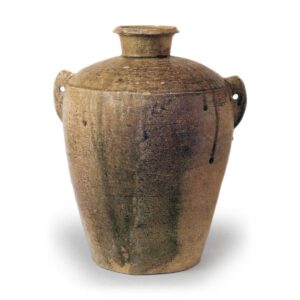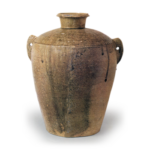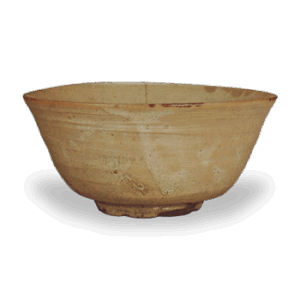
9th century
Height 36.5 cm, mouth diameter 9.2 cm, body diameter 26.4 cm, bottom diameter 16.5 cm
This so-called “double-ear” vase, with flattened ears with small holes on both sides of the shoulder, is one of the forms found throughout Japan from the late 8th century to the 10th century.
While the basic form of the long-necked vase in western Japan and Hokuriku is a long-necked vase with a trumpet-shaped opening at the neck, that of the Tokai region has a short, small neck, clearly showing the regional differences. The twin-necked jars of the Tokai region originated as primitive ash-glazed ceramics at the Sanage kiln around the end of the 8th century. Early examples had flat, crescent-shaped ears with small holes, but by the end of the 8th century, the ears had lengthened, and by the 9th century, the tops had become inflected and the ears were angular. The shoulders are also characteristic of this period, as are the ridged and inflected shoulders. It is flat-bottomed throughout the entire period and has no base.
This ash-glazed pottery from the Sanage kiln, dating from the early 9th century, is the finest example of twin-ear vase known today. It is made of high-quality white, highly refractory clay and fired with a neutral fire, similar to oxidized fire, and shows a light brown fire color unique to the Sanage kiln on the surface of the vessel. The yellowish green ash glaze applied to the entire surface from the neck of the mouth to the shoulder of the body runs down halfway across the body, and together with the size of this vessel, it gives it an imposing appearance.








